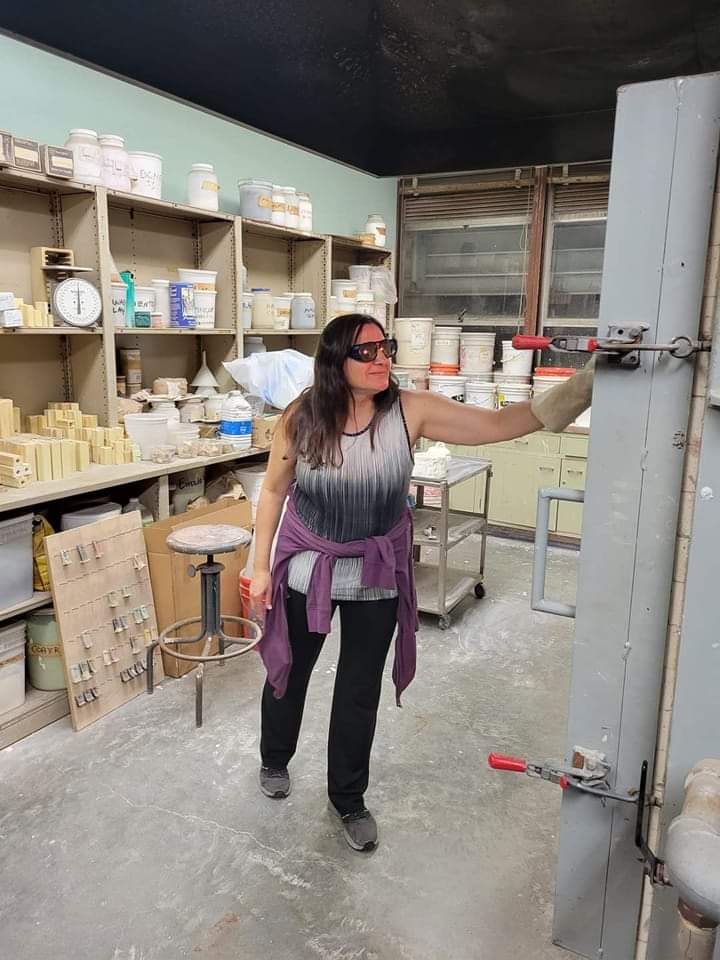I’m checking the temperature of the gas kiln

To begin with, if you are serious about taking your pottery or ceramics art practice to the next level and upgrading your pottery studio by investing in a kiln, you should know that gas and electric kilns are the most popular kinds of technology used for homes and workplaces. The end products of firings in such kilns may be as diverse as the energy sources used to produce them. This blog discusses the relative merits of gas and electric kilns, with the purpose of helping you decide which is right for you.
First of All: Consider your goals
First, we need to discuss what you want to accomplish before we can even begin to explore the advantages of gas kilns vs electric kilns.
As a ceramics artist, finding the appropriate kiln may be difficult, and it’s natural to have many questions along the way. What should I get? Should I choose a gas or electric kiln? When would I start to see the variations in my output? What does a gas kiln cost? And a cordless, battery-operated model? Which one do you think I should get if I want to succeed?
Many of these questions have the same, or similar, best answer: “choose the right one for your goals and artistic aspirations.” However, as we will see, it is also important to know the main characteristics and differences between these two kiln types in order to make the best decision while considering your own goals, needs, and tastes.
Despite the fact that many ceramics studios originally used wood and some still do because real fire, the interaction of ash with the pieces, and even the smell of wood interest ceramics artists and potters in their creative processes, gas and electric kilns have largely replaced them because of their lower costs, greater efficiency, and greater practicality.
Gas Kiln: Main Features
Gas kilns are very popular for firing ceramics art and pottery because they can reach extremely high temperatures in a short period of time and because ceramics artists can control the quantity of air flowing into the chamber to modulate the flame and the temperature. Artists may benefit from and are encouraged to try out a variety of fire temperatures and durations to get unique and engaging outcomes.
1. Temperature features
As we said that high temperatures can be attained and sustained rapidly; hence, it takes just a few minutes to change a clay art or ceramic into a long-lasting work of art.
These days, many gas kilns are equipped with inverted flame technology, which guarantees consistent temperatures over the whole interior of the kiln and, therefore, the highest possible quality of the finished product.
Also, inverted flame kilns save money on gas use as compared to standard direct flame kilns, making them a promising area for energy conservation expenditures. However, the cost is greater because of this, and it often ranges from $10,000 to $18,000 USD.
The versatility of gas kilns in terms of temperature and flame control has a direct effect on the final product. Your clay art’s glaze finish and texture will be affected by the atmosphere you create, which is often part of the creative process and often help ceramics artists create one-of-a-kind ceramics art. Extremely high temperature kilns are ideal for firing delicate porcelain and stoneware.
Be cautious of your workplace.
Most gas-powered kilns run on propane or natural gas, and they’re not too expensive to buy, set up, and operate. Before purchasing a gas-powered kiln, think about the location where it will be installed; this is because you will need to arrange for permits and inspections.
There are often local laws and standards that must be met before the hood can be installed, as well as the vent and gas lines. Safe operation of the kiln necessitates that gas cylinders or the location of the propane or natural gas supply be maintained at least ten feet away from the kiln at all times. For this reason, the processes established by the regulations examine the spots where the vent and gas lines will be installed.
Therefore, the best method to guarantee that you can install a gas kiln and take your works to the next level is to consult and allow yourself be guided by a professional, such as the specialists who accompany the procedures of purchasing, installing, and keeping kilns in peak condition.
Gas Kilns are flexible in terms of cost.
Gas kilns may be more or less cost-effective depending on a number of factors, including kiln size, the availability of technologies that provide temperature uniformity and modulation, the simplicity with which installation rules can be approved, and, of course, the size of your wallet.
Electric pottery kiln: Are they any better?
This century saw the development of electric kilns, which could maintain a constant, pleasant fire temperature for extended periods of time that help create unique ceramics art. They originated during the industrial revolution as a consequence of the need for new heating methods and have since taken on a wide variety of forms, each optimized for a certain use, such as the manufacture of ceramic or pottery goods, tiles, bricks, and so on.
Allows temperature control from inside.
Electric kilns, as its name implies, rely on electricity to generate high temperatures for the fire process. A wide variety of materials are viable options for use in an electric kiln due to their ability to insulate, endure, and regulate the tremendous heat needed for firing. The brick used to line the inside of these kilns is often exceedingly porous, pliable, and mushy. This helps the ceramics artists to heat the clay art at a constant temperature and create one-of-a-kind ceramics art.
All of the electric kiln’s inside walls are lined with special electric resistors or coils made of the same alloy to generate the high temperatures. After turning it on, the temperature can be readily adjusted so that the electric current heats the coils to the desired degree, creating a uniformly heated space ideal for your creations.
- Keep an eye on the voltage.
Electric kilns need modification for the local power grid. Most electric kilns need anywhere from 9 amps to 56 amps of electricity, depending on their size, and are connected to operate on either 240 volts or 208 volts.
However, this is generally relatively simple to determine, since 240-volt service is standard in most residential areas and 208-volt service is standard in most industrial buildings and schools. Therefore, if you fall into one of these categories, you need to make sure that the voltage of your electric kiln is appropriate.
When thinking about voltage, one must also consider current. The standard for residential wiring is 100 amps. For this reason, a kiln with a specified maximum current draw of 56 amps requires a circuit with a minimum capacity of 68 amps to accommodate the inevitable fluctuations in power consumption that occur throughout the fire process.
How much is an electric kiln?
Safety, cheap prices, convenience of use, and the ability to burn a broad variety of materials have made electric kilns increasingly popular. How much do ceramic kilns typically cost, though?
Power sources, physical dimensions, and technological sophistication are all factors. A good electric kiln may be set up for roughly $1000 US. Conversely, you can get a highly effective kiln for under $9,000 US.
It all circles back to the first inquiries. Exactly what do you hope to accomplish? In the capacity of a ceramics artist. For use in ceramics or pottery studio. As a creative kind.
This isn’t a battle between gas and electric kilns so much as a comparison of the two. Both of these kiln types have their own advantages. Right now, all you have to do is choose the one that works best for you.


